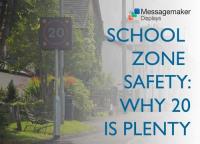 Add My Company
Add My Company
Sign In
SCHOOL ZONE SAFETY: WHY 20 IS PLENTY
09-01-2023

Every 22 minutes, someone is killed or seriously injured on UK roads. Now more than ever, road safety is of paramount importance. To combat ongoing road safety issues, legislation changes are being implemented all over the UK, including reducing speed limits in busy residential areas from 30 to 20mph.
Schools zones in particular have faced ongoing challenges in regards to speeding incidents, with research showing over a fifth of drivers exceeding the speed limit around these areas.
The following blog aims to provide an overview of the “20’s plenty” movement, and why it is so important, particularly around school zones.
20’s plenty movement
Back in 2018, 50% of all road casualties occurred on 30mph roads. In an attempt to reduce the number of accidents and injuries on British roads, UK towns and cities have been introducing more and more 20mph zones over the past few years.
There are three primary motivations for implementing 20mph zones; transport related (e.g. casualty and congestion reduction), community related (e.g. community concerns about safety and quality of the environment), and health related (e.g. encouraging more active travel such as walking and cycling).
Further to this, the environmental impact “20’s plenty” can have is yet another reason for the progression of the movement. Research has concluded that driving at slower speeds produces lower emissions when compared to driving at higher speeds, thus improving air quality.
The Welsh Government is set to default speed limits in urban areas from 30 to 20mph as a national requirement by April 2023. So far, 8 communities across Wales have been selected to introduce the new 20mph default speed limit including areas in Pembrokeshire, Cardiff and Monmouthshire. The data gathered from these communities will serve as support to inform future decisions.
School zone congestion and safety issues
For schools all over the UK, the school run can be a cause of huge traffic congestion and major road safety concerns. Congested traffic can then of course lead to wider issues such as journey delays, traffic collisions and a negative environmental impact. Traffic congestion on roads not only increases the fuel consumption, but consequently leads to an increase in carbon dioxide emissions and outdoor air pollution as well as an increase in the exposure time of the passengers.
The Royal Society for the Prevention of Accidents (ROSPA) found that every month 1,200 children are injured in traffic related collisions that occur within a 500m radius of a school. This is commonly occurring drop-off and pick-up times, with nearly half of all road accidents that happen on the road will occur between the hours of 15:00 and 18:00.
How schools can benefit from 20’s plenty
As research proves, lower the speed of the vehicle, the few incidents occur on the roads. When reviewing the impact of the introduction of 20mph limits across Calderdale in West Yorkshire, Councils found there was a 40% reduction in casualties on the roads.
Furthermore, reducing speed limits around school zones will not only ease parental concerns around child safety, but also parental concerns around air quality. As previously alluded to, driving at slower speeds can improve air quality through producing lower emissions.
As research suggests, driving at 20mph allows traffic to flow more freely when compared to driving at 30mph, thus reducing congestion. This is due to motorists making better use of the road space by packing closer, also allowing junctions to work more efficiently and at higher capacity. As slower speeds will help parents and students feel safer on the roads, parents are more likely to leave their vehicles at home, thus further reducing congestion. A reduction in congestion will subsequently lead to vast improvements in journey times and air pollution rates.
The role of signage in school hazard warning and speed enforcing in urban areas
As new laws are introduced, signage will be vital when enforcing changes and creating awareness to road users. LED signage in particular will act as an eye-catching communication tool, alerting motorists to any potential speeding and encouraging them to reduce their speed.
The use of LED signage has been proven to reduce speeding, as concluded from data collected from a Vehicle Activated Sign (VAS) located in the UK. Over a two and a half week period, following the implementation of a Messagemaker Displays VAS on this road, recordings were taken on the 1st September, 7th September and 17th September. Most notably, the average speeds and the highest speeds were analysed. The average speed reduced from 39mph, to 38.8mph, to 28.8mph respectively. The Highest recorded speed also fell from 61.8mph, to 60.4mph, to 46.6mph respectively.
The vast reduction in speed an LED sign can facilitate can also lead to wider implications on accident prevention and road safety in general; a primary issue around school zones.
Conclusion
Extensive research has gone into the progression of the “20’s plenty” movement, with the ultimate goal of minimising road traffic incidents and saving lives across the UK. As demonstrated, the reduction in speed in urban areas can be extremely beneficial, particularly in regards to accident prevention, congestion, and air quality.
School zones are a key area in which 20mph speed limits would have a large impact. Nearly half of all road traffic incidents occur during the hours of 15:00 and 18:00, leading to around 1,200 children being injured every month.
Looking to support future efforts, LED signage can be used to support the movement, creating awareness to road users, alerting them to any potential speeding and encouraging speed reduction.
For more information on SCHOOL ZONE SAFETY: WHY 20 IS PLENTY talk to Messagemaker Displays Ltd
Enquire Now
List your company on FindTheNeedle.

